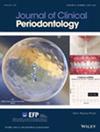Clinical Features Associated With Periodontal Case Misclassification by an Active Matrix Metalloproteinase-8 Point-of-Care Oral Rinse Test
Abstract
Background
The diagnostic performance of active matrix metalloproteinase-8 (aMMP-8) point-of-care oral rinse test (POC-ORT) for periodontitis needs to be improved because of its relatively low sensitivity. This study attempted to identify the clinical features associated with the misclassification of periodontal cases by the test.
Method
This work consisted of two cross-sectional diagnostic accuracy studies involving a representative cohort in Hong Kong, China, and a convenience sample of subjects in Shanghai, China. The outcomes of the aMMP-8 POC-ORT (index test) were compared to the case definitions of the 2017 World Workshop on the classification of periodontal health status (reference test). The analysis reports the diagnostic accuracy parameters, the Youden index and correlations between the aMMP-8 test outcomes and clinical features.
Results
In this study, 384 and 390 subjects were enrolled in Hong Kong and Shanghai, respectively. The conventional 20 ng/mL threshold failed to detect more than 50% of early-stage (I/II) cases. The positive POC-ORT results were significantly correlated with the number of sites with bleeding on probing (BOP), probing pocket depth (PPD) ≥ 4 mm, PPD ≥ 5 mm, PPD ≥ 4 mm and BOP, PPD ≥ 5 mm and BOP and clinical attachment loss. The adjusted odds ratio (OR) for a positive test increased with the number of sites with PPD ≥ 5 mm: 1.092 (95% CI: 1.063–1.127, p < 0.001) for the Hong Kong sample and 1.074 (95% CI: 1.050–1.100, p < 0.001) for the Shanghai sample, suggesting a higher likelihood of a positive result with each additional pocket ≥ 5 mm. The same was observed for PPD ≥ 5 mm with BOP: 1.093 (95% CI: 1.064–1.129, p < 0.001) and 1.077 (95% CI: 1.052–1.105, p < 0.001). Notably, the false-negative cases were characterised by a significantly smaller number of periodontal pockets, BOP percentages and bleeding pockets than the true-positive ones.
Conclusions
The false-negative cases, which are responsible for the observed low sensitivity of the POC-ORT, showed more localised periodontal inflammation and pocketing. As the oral rinse test measures the overall level of aMMP-8 cleared by the gingival crevicular fluid from various lesions throughout the whole dentition, localised periodontitis appears more difficult to detect. Additional studies are needed to optimise the sampling strategy and set the cut-off value of a positive test.
Trial Registration: The study was approved by the Institutional Review Board of the University of Hong Kong/Hospital Authority Hong Kong West Cluster (IRB Approval: UW22-132; trial registration: NCT03928080) and the Shanghai Ninth People's Hospital Ethics Committee (IRB Approval: SH9H-2021-T408-3; trial registration: NCT05513599)


 求助内容:
求助内容: 应助结果提醒方式:
应助结果提醒方式:


